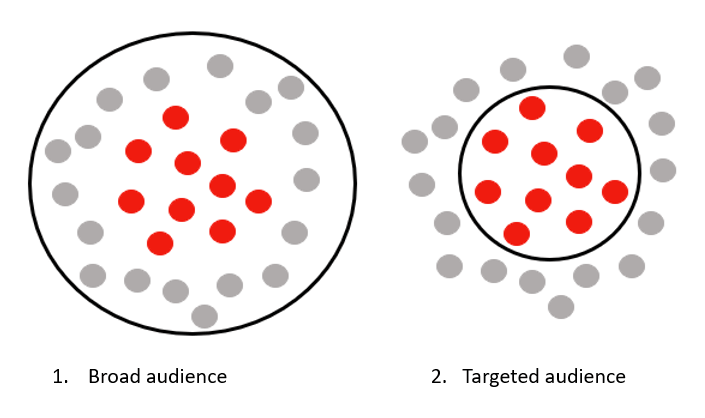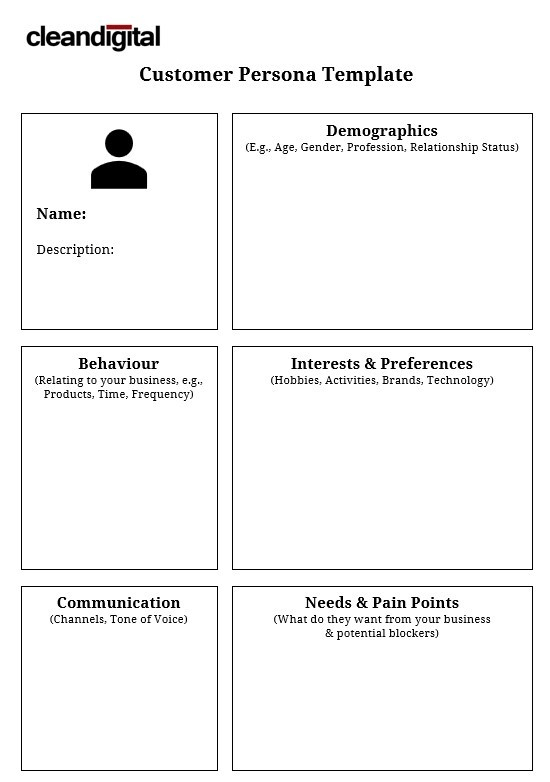There are many approaches to advertising, but a “one size fits all” targeting method will rarely provide the results you desire.
Consider the (semi-sensical) analogy of fishermen blindly trawling the ocean with a giant net. Their efficiency would be much improved by knowing their catch; where are they found, what are their habits, what bait do you use, etc.
Like frivolous fishermen, advertisers targeting an entire population are wasting their resources. By understanding your target market, you can focus your efforts on those most likely to bite.
So, how do we better understand our audience?
Customer Personas: Customer, buyer, or marketing personas are the map to your catch/customers and can be highly valuable tools in guiding your marketing strategy.
What are Customer Personas?
Customer Personas are semi-fictional characters based on your current or prospective customers. Each persona represents a distinguishable group of a business’s audience, often characterised by similar demographics, interests, behaviours or pain points.
Typically, businesses will have multiple customer personas, each representing separate segments of their target market. This segmentation allows advertisers to focus their efforts. They can tailor their marketing strategies to meet each segment's needs and preferences effectively.
Customer Personas can be a great instrument in applying the textbook STP (Segmentation, Targeting, Positioning) Model, a key marketing strategy.



Personas in Practice
Being the entrepreneurial go-getter you are, you’ve not only caught the fish from earlier but are now running a restaurant. Observing your clientele, you notice that they can be segmented into distinct groups, each with their own unique behaviours and needs:
- Grannies: Women aged 60+ who come in for a coffee and cake mid-morning
- Griswold's: Families who come in for dinner during the week
- Geezers: Men aged 20+ who come to watch the sports with a drink
Except for some potential cross over between the Griswold's and the other groups, each persona has distinct characteristics. With this said, if you chose to run a marketing campaign with one audience, you’d have to target and cater for everyone from Grannies to Geezers (…everyone?).
Reflecting on the different habits of your customer base is crucial. Look at the types of products or services purchased, frequency of purchase or visit, days of the week, and time of the year. By identifying these patterns, you can define the characteristics that distinguish these customers.
Why You Need Customer Personas
Customer Personas can help you and your team to better understand your customers, allowing you to:
-
Spend your marketing budget efficiently: Simply, by focusing your advertising spend on your desired audience, and minimising wasted spend on anyone outside of your target market, you can improve marketing efficiency.
- Improve engagement with bespoke ads: Understanding your customer personas allow for better positioning. You can tailor your messaging to meet the needs and preferences of each group. Like fishermen selecting their bait.
For example, the Grannies, Griswold's, and Geezers all visit the restaurant for different reasons - morning coffee, midweek dinner, or for live sport. This patterned behaviour enables advertisers to tailor content for each group, such as offering cake and coffee discounts for Grannies, dinner discounts for the Griswold's, and live sport reminders for Gary. - Reach customers on the right platform: Different personas may be best reached in different places. By understanding this, you can coordinate your marketing efforts to reach the desired users in the right place and at the right time.
A Balancing Act
For the above reasons, Customer Personas can be a great way to exploit your understanding of your current customers. However, while they help you target known converting characteristics, they will not assist much in discovering new audiences.
This is where a broad targeting approach earns its worth. It has the potential to reveal new audiences. Take the restaurant example: here, it might not yet be discovered that the venue will be a big hit with young couples, or people of even less predictable characteristics, like marathon runners or readers of true crime.
So, while exploiting known converters in the form of customer personas is highly efficient, time and resources should also be reserved for exploring new audiences to allow growth. This balance is often referred to as the Exploration and Exploitation Framework. Many theorise that this is best struck at an 80:20 ratio, with 80% of resources dedicated to exploiting existing knowledge and 20% assigned to exploring new ideas or opportunities. But we can take a deeper dive into this on another day.
Personas in Practice: Their Role in Digital Marketing
The targeting capabilities of digital marketing platforms only continue to grow. From Job Title targeting on LinkedIn, relationship status on Meta, to the content users engage with on TikTok, the tools to get granular with your targeting (and recreate your customer personas) are in abundance.
Keeping it simple, let's create an audience for the beforementioned "Geezers", using Meta's (Facebook & Instagram) targeting options:
Demographics:
- Age: 21-40
- Gender: Male
- Location: Edinburgh
Interests:
- Pubs Goers
- Beer, Alcohol, Restaurants, etc
- Football Fans
- Football media, Premier League, World Cup, etc
With the above targeting, we have created an audience of between 43,000 and 50,000 people. Depending on our campaign strategy and objectives, we can narrow or grow our audience with each detail we include. For example, if we decided to grow our audience above, we could alter our restrictions to find football or rugby fans – doing so would grow our audience by an extra 4,000 users.
In comparison, if we only targeted users in Edinburgh, our audience would be between 454,000 and 534,000 in size. This 10 to 1 difference in audience size, between broad and a specific targeting, helps to illustrate the importance of defining our audiences: to focus spend on our target market and reduce wasted spend on those outside it.
In Summary
Customer personas play a critical role in digital marketing, helping businesses to understand their audiences better and tailor their marketing strategies accordingly. They allow us to focus our marketing efforts on the right people, at the right time, and in the right place. Whether it's creating more relevant ad content, optimising our advertising spend, or reaching customers on their preferred platform, the benefits of using customer personas are clear. As we move towards an increasingly personalised marketing landscape, understanding and applying customer personas becomes not just beneficial, but essential for businesses seeking to connect with their customers effectively and efficiently. Just as a seasoned fisherman understands the importance of knowing their catch, in the ever-evolving world of digital marketing, customer personas remain a steadfast tool for understanding and defining your audience.
Customer Personas Template
Finally, we’ve created a Customer Persona Template, which you can find below. Use this to map out your customer segments, identify their unique characteristics, behaviours, and needs. Remember, the more you understand your customer, the better you can serve them. And if you need any further assistance in refining your digital marketing strategy or understanding your audience, our team at Clean Digital is always here to help.
As always, we love discussing all things PPC, so don't hesitate to get in touch!
Want to learn more about the world of digital marketing? Check out our other blogs here!








